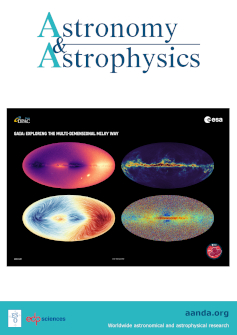丰富的星际二腈库:在 TMC-1⋆ 中探测到丙二腈和马来腈
IF 5.4
2区 物理与天体物理
Q1 ASTRONOMY & ASTROPHYSICS
引用次数: 0
摘要
腈基是迄今为止星际分子中最常见的基团,而星际二腈(含有两个 -CN基团的分子)的存在最近也得到了证实。在这里,我们报告在冷致密云 TMC-1 中发现了两种新的二硝基化合物。这些新发现的物质是丙二腈(CH2(CN)2)和马来腈(NC-CH=CH-CN 的 Z 异构体),它们可以看作是分别用甲烷和乙烯中的两个 -CN 基团取代两个 H 原子的结果。这两种分子是利用耶贝斯 40 米望远镜正在进行的 TMC-1 QUIJOTE 线测量数据探测到的。我们得出丙二腈和马来腈的柱密度分别为 1.8 × 1011 cm-2 和 5.1 × 1010 cm-2。这意味着它们的含量分别比 HCC-CH2-CN 和 (E)-HCC-CH=CH-CN 低八倍和三倍,后者是在 TMC-1 中检测到的类似分子,其中一个 -CN 基团转化为一个 -CCH 基团。这与之前的研究结果一致,即在 TMC-1 中,-CCH 衍生物的含量高于-CN 衍生物。我们研究了这两种二腈的潜在化学途径,发现马来腈可以通过 CN 与 CH2CHCN 的反应有效形成,而丙二腈的形成则不清楚,因为在 TMC-1 的物理条件下,可能形成丙二腈的中性-中性反应并不可行。本文章由计算机程序翻译,如有差异,请以英文原文为准。
The rich interstellar reservoir of dinitriles: Detection of malononitrile and maleonitrile in TMC-1⋆
While the nitrile group is by far the most prevalent one among interstellar molecules, the existence of interstellar dinitriles (molecules containing two −CN groups) has recently been proven. Here we report the discovery of two new dinitriles in the cold dense cloud TMC-1. These newly identified species are malononitrile, CH2(CN)2, and maleonitrile, the Z isomer of NC−CH=CH−CN, which can be seen as the result of substituting two H atoms with two −CN groups in methane and ethylene, respectively. These two molecules were detected using data from the ongoing QUIJOTE line survey of TMC-1 that is being carried out with the Yebes 40 m telescope. We derive column densities of 1.8 × 1011 cm−2 and 5.1 × 1010 cm−2 for malononitrile and maleonitrile, respectively. This means that they are eight and three times less abundant than HCC−CH2−CN and (E)-HCC−CH=CH−CN, respectively, which are analog molecules detected in TMC-1 in which one −CN group is converted into a −CCH group. This is in line with previous findings in which −CCH derivatives are more abundant than the −CN counterparts in TMC-1. We examined the potential chemical pathways to these two dinitriles, and we find that while maleonitrile can be efficiently formed through the reaction of CN with CH2CHCN, the formation of malononitrile is not clear because the neutral-neutral reactions that could potentially form it are not feasible under the physical conditions of TMC-1.
求助全文
通过发布文献求助,成功后即可免费获取论文全文。
去求助
来源期刊

Astronomy & Astrophysics
地学天文-天文与天体物理
CiteScore
10.20
自引率
27.70%
发文量
2105
审稿时长
1-2 weeks
期刊介绍:
Astronomy & Astrophysics is an international Journal that publishes papers on all aspects of astronomy and astrophysics (theoretical, observational, and instrumental) independently of the techniques used to obtain the results.
 求助内容:
求助内容: 应助结果提醒方式:
应助结果提醒方式:


